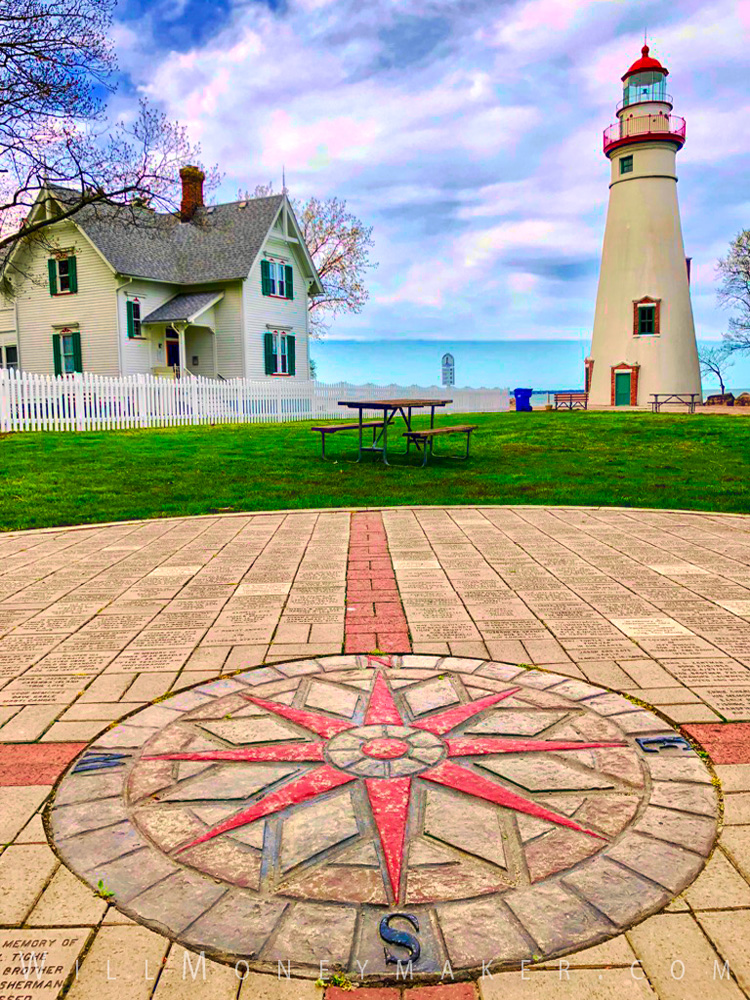Located in lovely Marblehead, Ohio, the Marblehead Lighthouse is the oldest continuously operated lighthouse on the US side of the Great Lakes. Opened in 1822, it has guided untold numbers of ships and boats along the rocky Marblehead Peninsula. Today, this venerable lighthouse is part of the nine-acre Marblehead Lighthouse State Park, which is operated by the Marblehead Lighthouse Historical Society. If you are in the area, it is an attraction of local color and history that is well worth the visit.
The park includes not only the Marblehead Lighthouse, but the Marblehead Lighthouse Museum (located in the old lighthouse keeper’s house), picnic areas, and beautiful views of Lake Erie and Sandusky Bay. Exhibits on site include a Fresnel lens, ice fishing, ice harvesting, ships, fossils found locally, shipwrecks, local maritime history, a Lifesaving station replica, and an authentically restored Coast Guard rescue boat (including the launching railway).
The lighthouse is open for tours in the summers. The museum at the old keeper’s house is open whenever tours are being given.
The Marblehead Lighthouse was authorized in 1819 when Congress acknowledged a need for navigational aids on the shores of the Great Lakes. To this end, $5,000 was put aside to construct a lighthouse at the entrance of Sandusky Bay. Contractor William Kelly, with local assistants Amos Fenn and William B. Smith, was enlisted to build the lighthouse in 1821. The lighthouse was built as a fifty-foot tower made of local limestone quarried at the tip of Marblehead Peninsula. The lighthouse’s base is twenty-five feet in diameter, with five-foot thick walls at the base. The lighthouse gradually narrows to twelve feet in diameter at the top, with two-foot thick walls.
While the lighthouse is operated by automation now, this was not always true. Before the Industrial Revolution and the invention of modern technology that allowed for such automation, the lighthouse required actual people to operate it. Over its history, fifteen lighthouse keepers have tended it, making sure its beacon was on and pointing in the proper direction at the right times. Two of these lighthouse keepers were women. The first recorded keeper at the lighthouse was Benajah Wolcott, who was a veteran of the Revolutionary War, and an early settler of the peninsula.
When Wolcott took the job, the lighthouse and its adjacent keeper’s house made of stone were brand new. Wolcott moved into the keeper’s house with his family. His job was to light thirteen whale oil lamps each night, as those were the lighthouse’s first means of illumination. The lamps each had several sixteen point zero inch diameter metal reflectors on them, which helped push the light they emitted across the lake. Wolcott also had to keep a log of passing ships and local weather conditions, and also had to organize any necessary rescue efforts.
Wolcott died in 1832, and his wife Rachel took over the duties of the lighthouse keeper. When she remarried to Jeremiah VanBenschoter, he took over as the new lighthouse keeper. These three people, all connected to each other by marriage, comprised the lighthouse’s first three keepers.
In 1858, the whale oil lamps were replaced with one single kerosene lamp, whose light was magnified appropriately by a Fresnel lens. A Fresnel lens is a special lens of curved glass that creates a bright, fixed white light when used against a light source (such as the kerosene lamp at the Marblehead Lighthouse).
Other improvements to the original structure include the replacement of the original stone lighthouse keeper’s house with the current wood-framed house in 1880. The new house was much larger than the first one. In 1876, a lifesaving station was built a half-mile west of the lighthouse. This was done after Lucien Clemons and his two brothers saved two sailors from a shipwreck on the peninsula the year prior.
The new technology that we might recognize as modern came to the lighthouse after the turn of the century. Fifteen more feet were added to the height of the lighthouse. A mechanism of rotating gears is used in a clock was installed to automatically turn the lantern in the lighthouse. The turning creates a bright flash of light every ten seconds. The lighthouse keeper had to crank the weights on the gears by hand every three hours from dusk to dawn so the lantern would continue to turn while sailors needed it to navigate. A new and improved Fresnel lens was also installed; the new one had prism surfaces, which created an even more brilliant light than the previous lens did.
Electric lighting did not replace the kerosene lamp until 1923. This made the light and its signal even brighter. Marblehead Lighthouse became a point for important strategic defense during WWII. Civilian lighthouse keepers were replaced with Coast Guard managers in 1946. The light itself became automated in 1958. That same year, the battered-looking original lighthouse was treated to a new coat of stucco.
The Ohio Department of Natural Resources assumed ownership of the property around the lighthouse in 1972, and of the lighthouse itself in 1998. The lighthouse is still used and operated as a working lighthouse today, and the Coast Guard continues to manage this job, as it has done since it replaced civilian lighthouse keepers. An LED light was installed in the lighthouse in 2012. It flashes a green light signal every six seconds, which is visible from eleven nautical miles away. The green light distinguishes it as a lighthouse light, as local air beacon lights are the old-fashioned white the lighthouse used to produce. The green light eliminates confusion over what light belongs to what building.
The lighthouse and keeper’s house were renovated in 2001, costing half a million dollars to accomplish. The Fresnel lens was given back to the lighthouse in 2004 to become part of the permanent display there (it had previously been on display at the Marblehead Coast Guard Station)
If you would like to visit this delightful and historically important and fascinating park, it is open from Memorial Day through Labor Day, each day from noon to 4 pm. It is well worth a visit.







